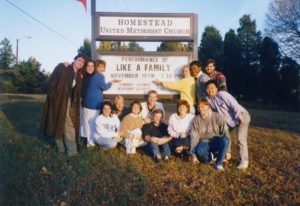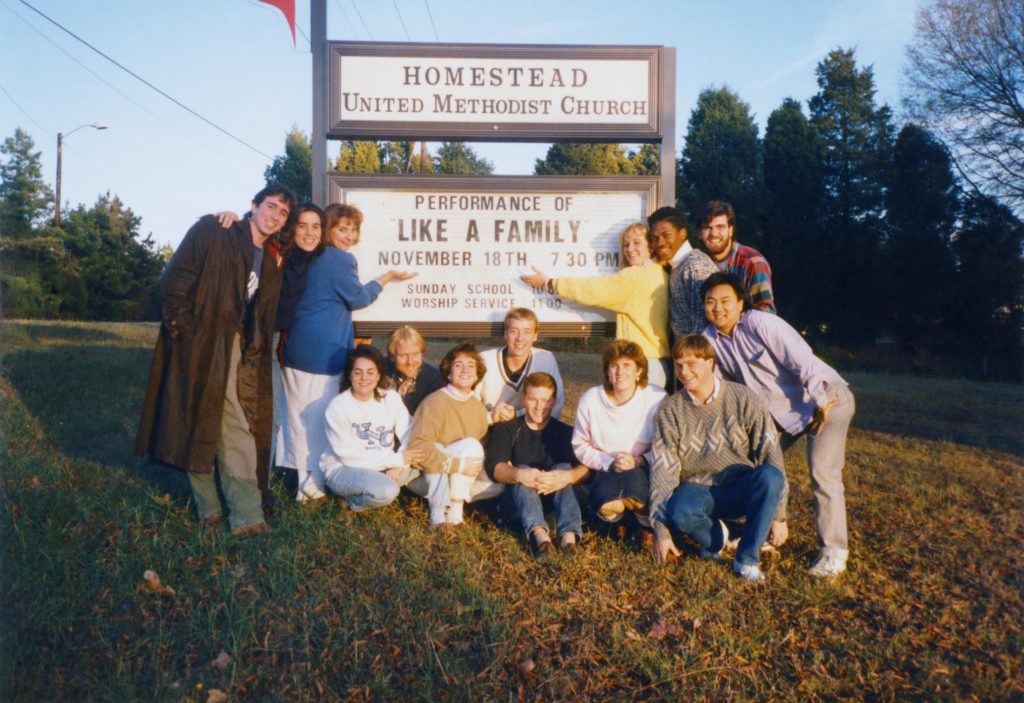Follow our weekly series, Throwback Thursday, designed to help celebrate 50 years of OHA. We’ll profile a year in the life of the organization each week with photos, logos, and highlights taken from the Oral History Association Newsletter. We welcome your memories, photos, and comments at oha@gsu.edu.
OHA in 1989…

Performing Like a Family, 1988: Photograph of performance ensemble, production staff, and Like a Family co-author Robert Korstad at Homestead United Methodist Church, across from the defunct Homestead Mills in Charlotte, N.C. Photo credit: Southern Oral History Program, University of North Carolina at Chapel Hill
President: Lila Johnson Goff, Minnesota Historical Society
Site of the Annual Meeting: Galveston, Texas
Newsletter: Jaclyn Jeffrey, editor
Editorial office: Baylor University, Waco, Texas
Annual individual membership: $20
Highlights of the year from the 1989 Oral History Association Newsletter:
- Efforts were being made to move forward with new titles for the OHA Pamphlet series. OHA was in talks with the American Association for State and Local History regarding a publishing partnership given the large membership of AASLH who might be interested in oral history and its marketing experience. Editors were being solicited for publications on community history, family history, grantwriting, folk like, and material culture. Oral History in the Secondary Classroom had recently been published.
- “Have nuclear weapons kept the peace or endlessly endangered humanity? The lack of information needed to answer that question generated the establishment of the Nuclear History Program, an international research effort founded in 1987.” The Spring 1989 newsletter featured the collaborative work of the NHP as it sought to develop primary source material for its three main research areas: issue-oriented projects, national nuclear histories, and broad-scale analyses of the impact of nuclear weapons internationally.
- OHA members adopted the first revision to the association’s Evaluation Guidelines at the business meeting in 1989. Originally prepared at the Wingspread Conference in 1979, the guidelines offer a series of questions for “evaluating the conduct, processing, and preservation of oral history collections.”
- “We wanted to keep the stories alive and keep history ongoing,” said Della Pollock as she described the impetus for “Performing Like a Family” in the Spring 1989 newsletter. Eleven UNC undergrads in an independent study course completed Pollack’s vision for a performance based on the award-winning book about Southern cotton mill villages. Students pulled characters and dialogue from the award-winning book and wove them together into a script. Built into the script were opportunities for interaction between performers and the audiences which were comprised mainly of mill workers and related community workers.
Who were we interviewing in 1989?
- Alaska Humanities Forum — Chugach and Kodiak natives about the impact of the Exxon Valdez oil spill on nearby native villages.
- National Gallery of Art — persons associated with the the early years of the gallery as it prepares to celebrate its upcoming 50th anniversary.
- The Center for Oral History, University of Hawaii at Manoa — former residents and workers on Wakiki Beach before tourism, covering topics ranging from Japanese laundry to the original beach boys.
